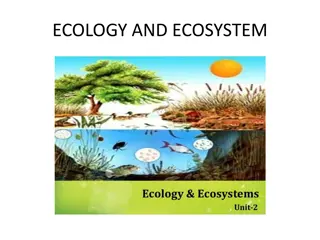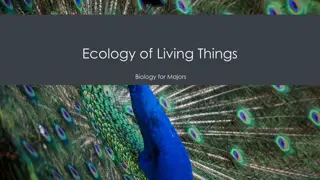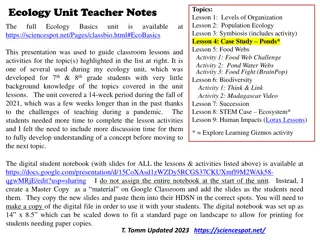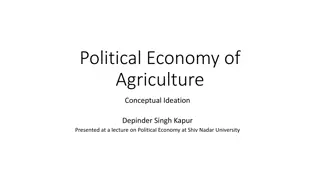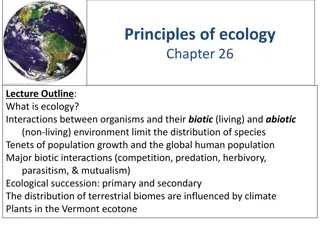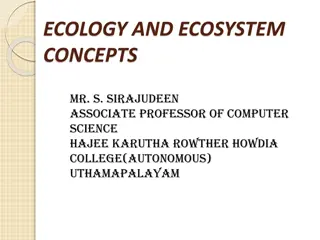Understanding the Holistic Approach in Home Economics and Human Ecology
Delve into the concepts of STEM and STEAM within Home Economics and Human Ecology to explore the importance of interdisciplinary, integrative, and collaborative approaches. Learn about the holistic perspective, appreciating the difference between monodisciplinarity, multidisciplinarity, and interdisciplinarity. Discover the significance of considering a whole system of factors rather than individual components, fostering a comprehensive understanding and holistic solutions.
Download Presentation

Please find below an Image/Link to download the presentation.
The content on the website is provided AS IS for your information and personal use only. It may not be sold, licensed, or shared on other websites without obtaining consent from the author. Download presentation by click this link. If you encounter any issues during the download, it is possible that the publisher has removed the file from their server.
E N D
Presentation Transcript
STEM and STEAM within Home Economics and Human Ecology MHETA PD Day October 19, 2018 Selkirk, MB Sue L. T. McGregor PhD IPHE Professor Emerita (MSVU) McGregor Consulting Group www.consultmcgregor.com
Well get to these after this PowerPoint STEM and STEAM Science, Technology, Engineering and Mathematics Science, Technology, Engineering, ARTS and Mathematics These approaches depend heavily on a combination of: interdisciplinarity integrative curriculum collaborative team work
Let us take the time to appreciate what they mean to us before we link us to STEM and STEAM
We have always called ourselves a holistic, interdisciplinary and integrated profession, but what do those words actually mean for us?
HOLISTIC Greek holos "whole" Holistic refers to taking into consideration a whole system of factors rather than just separate factors. It ties in with the concept of "wholeness" (completeness, unity, fullness, comprehensive, entirety)
Appreciating the difference between: Monodisciplinarity Multidisciplinarity Interdisciplinarity our longstanding mantra meaning it is repeated without thinking about it
Monodisciplinary (mono=one, alone) This involves onelone academic discipline e.g., law, economics, sociology People working in one discipline study the same research objects, share the same paradigm (world view and set of assumptions about the world), use common methods, and speak the same language and lingo From a monodisciplinary approach, only one discipline is brought to bear to solve a societal problem Worse yet, it may be that just one branch within this one discipline is drawn upon leading to deep, fragmented specialization (e.g., classical economics but not feminist, behavioral or ecological economics)
Multidisciplinary (multi= more than one, but driven by one) This work involves mingling disciplines to problem solve an issue identified by ONE discipline, with each discipline maintaining its distinctiveness Multidisciplinary work does not entail integrating knowledge into new patterns; it is just the temporary sharing of information and knowledge from disparate disciplinary knowledge bases. Home economics might be the blue person (discipline) at the table.
Home economics disciplinary knowledge base comprises (blue person at the table): individual and family needs-specialized content (e.g., foods, shelter, clothing, child development, housing, consumer) aligned conceptual/theoretical disciplinary content (e.g., sociology, psychology, business, political studies, economics, law, engineering, mathematics, science, arts, humanities) home economics body of knowledge (BOK): integration of the above to ensure holistic and interdisciplinary practice
Interdisciplinary (inter means between) Although the multidisciplinary approach juxtaposes specialists by sitting them down beside each other at the table, the interdisciplinary approach coordinates their expertise Coordination entails organizing a complex enterprise in which numerous people are involved and bringing their contributions together to form a coherent or efficient whole The people involved offer parallel analyses of parts of a problem. A new synergy (i.e., advanced effectiveness as a result of cooperation) emerges from the facilitated sharing of information and creation of new knowledge, insights and/or methods among multiple disciplines sometimes even new disciplines emerge (e.g., bioethics) Interdisciplinarity involves assembling different disciplines around particular themes (issues) but there is no commitment to change the boundaries and relations among the disciplines. They usually go back to their respective disciplinary homes.
An aside: Knowledge Insidea person s brain Information becomes knowledge when the person receiving it has successfully integrated it into their existing cognitive framework he or she knows it because the external information is now firmly in their mind and/or committed to memory Information Outsidea person s brain By sharing, presenting or transmitting information, the intent is for people to come to know the information
Interdisciplinarity and home economics To prepare home economists to do interdisciplinary work, higher education university programs train students minds (or socialize them) to tease out content, theory and principles from aligned disciplines and then draw on the synergy created when mental connections ( aha light bulb moments) are made between these insights and home economics mission, philosophy, practice, and its own knowledge base. The intended result is holistic, integrated, interdisciplinary-informed practice that is focused on individual and family needs and functions People learn to think like a home economist and see the world through a holistic and integrated lens.
No one ever explained why I had to take all of those electives when I was getting my home economics bachelor degree. I wish someone had explained interdisciplinarity, integrated and holistic thinking to me 48 years ago! TODAY, my proudest accomplishment is knowing how to think like a home economist. It sets me apart from everyone else. I see things no one else sees because I can see patterns and connections and draw new meaning from them.
I have become home economics literate in that I now automatically think from a holistic, interdisciplinary and integrated perspective.
Interdisciplinary cont Done well, the interdisciplinary approach helps home economics practitioners to create patterns for interpreting the world through a multitude of disciplinary lens, while remaining focused on well- being and quality of life Interdisciplinary work involves integration synthesis synergy
Integrated, synthesis and synergistic Image result for integrate Integrated is Latin integrare, to make into a whole or make complete by introducing something into another existing entity Synthesis isLatin synthesis, combining into a collection. It is the process of placing different ideas, influences or objects into one place and then combining them to create a new whole Integration and synthesis involve synergy, Latin synergia, joint work when the combined effect of jointly working together is greater than the sum of people s individual effects or capabilities - like a really good lone trumpet player joining a jazz music ensemble
We have been integrated for a very long time 116 years and counting The Minutes of the 1902 Fourth Lake Placid meeting reported that the intent of home economics is to connect and bind together into a consistent whole the pieces of knowledge at present unrelated (as cited in Brown, 1993, p. 230). This early definition conceptualized . . . home economics as an integration of knowledge from various disciplines (Brown, 1993, p. 229).
More on integration Integration involves mixing things that are normally segregated (i.e., not mixed) The result is a new whole comprising parts from several sources, which often includes content, processes and perspectives from many disciplines and, ideally, stakeholders Integration is also about conceptual and perceptual connections. When information is presented in such a way that people are given the opportunity to weave things together (i.e., connect the dots) they can perceive things differently (see new patterns) and create integrated knowledge
Open separate PPT on Integrative Curriculum
Home economics has long depended upon and valued collaborative teamwork as a learning pedagogy. Related image
Collaborative Team Work Collaborate is Latin collaborare"work with (laborare "to work ) A team is a group of people working together for some purpose, ideally in the most effective and efficient way possible given the make up of the team. Each team member has a specific set of skills and a role to play in accomplishing tasks related to the work. Ideally, team members would have complementary skills (balancing strengths and weaknesses) and, if successful, would create synergy through their coordinated efforts (i.e., the result of their combined actions is greater than the sum of their individual actions).
What does collaborate look like: working together? agree on a shared vision and establish consensual goals and objectives for the task at hand engage in collective decision making and share accountability for its outcome meet frequently to expedite task completion and enrich interactions, sharing information in a timely and open manner establish non-hierarchical relationships (minimizing status and authority) to facilitate consensual partnerships and joint rule defining to keep things on task be open to and share different viewpoints with the intent to integrate them into innovative, creative solutions and strategies provide immediate and constructive feedback as they work together to get at the root causes of the issues being jointly considered Image result for collaborate
Now we are ready to move onto Image source: https://www.makeblock.com/wp-content/uploads/2018/08/STEMSTEAM-520x245.png Image result for STEM STEAM








